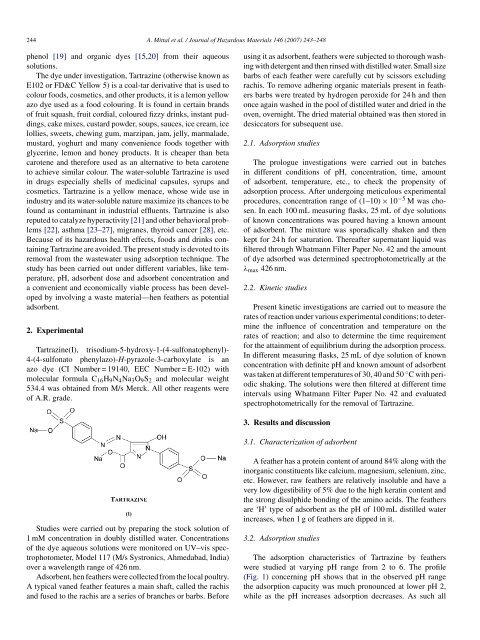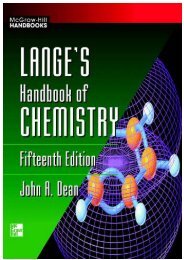Freundlich and Langmuir adsorption isotherms and kinetics for the ...
Freundlich and Langmuir adsorption isotherms and kinetics for the ...
Freundlich and Langmuir adsorption isotherms and kinetics for the ...
You also want an ePaper? Increase the reach of your titles
YUMPU automatically turns print PDFs into web optimized ePapers that Google loves.
244 A. Mittal et al. / Journal of Hazardous Materials 146 (2007) 243–248<br />
phenol [19] <strong>and</strong> organic dyes [15,20] from <strong>the</strong>ir aqueous<br />
solutions.<br />
The dye under investigation, Tartrazine (o<strong>the</strong>rwise known as<br />
E102 or FD&C Yellow 5) is a coal-tar derivative that is used to<br />
colour foods, cosmetics, <strong>and</strong> o<strong>the</strong>r products, it is a lemon yellow<br />
azo dye used as a food colouring. It is found in certain br<strong>and</strong>s<br />
of fruit squash, fruit cordial, coloured fizzy drinks, instant puddings,<br />
cake mixes, custard powder, soups, sauces, ice cream, ice<br />
lollies, sweets, chewing gum, marzipan, jam, jelly, marmalade,<br />
mustard, yoghurt <strong>and</strong> many convenience foods toge<strong>the</strong>r with<br />
glycerine, lemon <strong>and</strong> honey products. It is cheaper than beta<br />
carotene <strong>and</strong> <strong>the</strong>re<strong>for</strong>e used as an alternative to beta carotene<br />
to achieve similar colour. The water-soluble Tartrazine is used<br />
in drugs especially shells of medicinal capsules, syrups <strong>and</strong><br />
cosmetics. Tartrazine is a yellow menace, whose wide use in<br />
industry <strong>and</strong> its water-soluble nature maximize its chances to be<br />
found as contaminant in industrial effluents. Tartrazine is also<br />
reputed to catalyze hyperactivity [21] <strong>and</strong> o<strong>the</strong>r behavioral problems<br />
[22], asthma [23–27], migranes, thyroid cancer [28], etc.<br />
Because of its hazardous health effects, foods <strong>and</strong> drinks containing<br />
Tartrazine are avoided. The present study is devoted to its<br />
removal from <strong>the</strong> wastewater using <strong>adsorption</strong> technique. The<br />
study has been carried out under different variables, like temperature,<br />
pH, adsorbent dose <strong>and</strong> adsorbent concentration <strong>and</strong><br />
a convenient <strong>and</strong> economically viable process has been developed<br />
by involving a waste material—hen fea<strong>the</strong>rs as potential<br />
adsorbent.<br />
2. Experimental<br />
Tartrazine(I), trisodium-5-hydroxy-1-(4-sulfonatophenyl)-<br />
4-(4-sulfonato phenylazo)-H-pyrazole-3-carboxylate is an<br />
azo dye (CI Number = 19140, EEC Number = E-102) with<br />
molecular <strong>for</strong>mula C16H9N4Na3O9S2 <strong>and</strong> molecular weight<br />
534.4 was obtained from M/s Merck. All o<strong>the</strong>r reagents were<br />
of A.R. grade.<br />
Studies were carried out by preparing <strong>the</strong> stock solution of<br />
1 mM concentration in doubly distilled water. Concentrations<br />
of <strong>the</strong> dye aqueous solutions were monitored on UV–vis spectrophotometer,<br />
Model 117 (M/s Systronics, Ahmedabad, India)<br />
over a wavelength range of 426 nm.<br />
Adsorbent, hen fea<strong>the</strong>rs were collected from <strong>the</strong> local poultry.<br />
A typical vaned fea<strong>the</strong>r features a main shaft, called <strong>the</strong> rachis<br />
<strong>and</strong> fused to <strong>the</strong> rachis are a series of branches or barbs. Be<strong>for</strong>e<br />
using it as adsorbent, fea<strong>the</strong>rs were subjected to thorough washing<br />
with detergent <strong>and</strong> <strong>the</strong>n rinsed with distilled water. Small size<br />
barbs of each fea<strong>the</strong>r were carefully cut by scissors excluding<br />
rachis. To remove adhering organic materials present in fea<strong>the</strong>rs<br />
barbs were treated by hydrogen peroxide <strong>for</strong> 24 h <strong>and</strong> <strong>the</strong>n<br />
once again washed in <strong>the</strong> pool of distilled water <strong>and</strong> dried in <strong>the</strong><br />
oven, overnight. The dried material obtained was <strong>the</strong>n stored in<br />
desiccators <strong>for</strong> subsequent use.<br />
2.1. Adsorption studies<br />
The prologue investigations were carried out in batches<br />
in different conditions of pH, concentration, time, amount<br />
of adsorbent, temperature, etc., to check <strong>the</strong> propensity of<br />
<strong>adsorption</strong> process. After undergoing meticulous experimental<br />
procedures, concentration range of (1–10) × 10 −5 M was chosen.<br />
In each 100 mL measuring flasks, 25 mL of dye solutions<br />
of known concentrations was poured having a known amount<br />
of adsorbent. The mixture was sporadically shaken <strong>and</strong> <strong>the</strong>n<br />
kept <strong>for</strong> 24 h <strong>for</strong> saturation. Thereafter supernatant liquid was<br />
filtered through Whatmann Filter Paper No. 42 <strong>and</strong> <strong>the</strong> amount<br />
of dye adsorbed was determined spectrophotometrically at <strong>the</strong><br />
λmax 426 nm.<br />
2.2. Kinetic studies<br />
Present kinetic investigations are carried out to measure <strong>the</strong><br />
rates of reaction under various experimental conditions; to determine<br />
<strong>the</strong> influence of concentration <strong>and</strong> temperature on <strong>the</strong><br />
rates of reaction; <strong>and</strong> also to determine <strong>the</strong> time requirement<br />
<strong>for</strong> <strong>the</strong> attainment of equilibrium during <strong>the</strong> <strong>adsorption</strong> process.<br />
In different measuring flasks, 25 mL of dye solution of known<br />
concentration with definite pH <strong>and</strong> known amount of adsorbent<br />
was taken at different temperatures of 30, 40 <strong>and</strong> 50 ◦ C with periodic<br />
shaking. The solutions were <strong>the</strong>n filtered at different time<br />
intervals using Whatmann Filter Paper No. 42 <strong>and</strong> evaluated<br />
spectrophotometrically <strong>for</strong> <strong>the</strong> removal of Tartrazine.<br />
3. Results <strong>and</strong> discussion<br />
3.1. Characterization of adsorbent<br />
A fea<strong>the</strong>r has a protein content of around 84% along with <strong>the</strong><br />
inorganic constituents like calcium, magnesium, selenium, zinc,<br />
etc. However, raw fea<strong>the</strong>rs are relatively insoluble <strong>and</strong> have a<br />
very low digestibility of 5% due to <strong>the</strong> high keratin content <strong>and</strong><br />
<strong>the</strong> strong disulphide bonding of <strong>the</strong> amino acids. The fea<strong>the</strong>rs<br />
are ‘H’ type of adsorbent as <strong>the</strong> pH of 100 mL distilled water<br />
increases, when 1 g of fea<strong>the</strong>rs are dipped in it.<br />
3.2. Adsorption studies<br />
The <strong>adsorption</strong> characteristics of Tartrazine by fea<strong>the</strong>rs<br />
were studied at varying pH range from 2 to 6. The profile<br />
(Fig. 1) concerning pH shows that in <strong>the</strong> observed pH range<br />
<strong>the</strong> <strong>adsorption</strong> capacity was much pronounced at lower pH 2,<br />
while as <strong>the</strong> pH increases <strong>adsorption</strong> decreases. As such all














![Síntesis de los isómeros de enlace [Co(NH3)5(ONO)]Cl2 y - DePa](https://img.yumpu.com/16368707/1/190x245/sintesis-de-los-isomeros-de-enlace-conh35onocl2-y-depa.jpg?quality=85)


